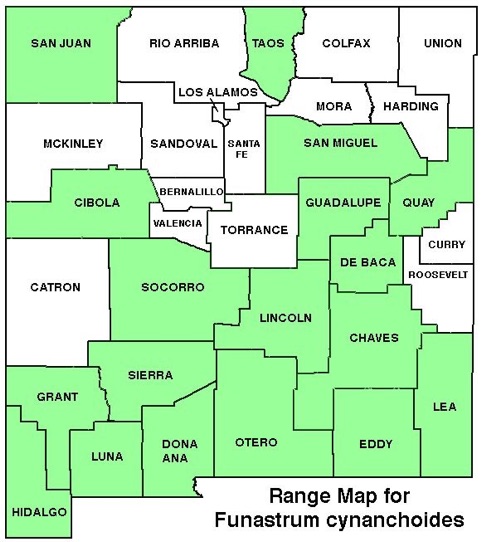WILDFLOWERS OF NEW MEXICO

The slender stems of this climbing vine twine up through shrubs and densely cover boulders, branches, and fences. Tangled stems covered with small leaves and flowers can form a dense curtain. Note the round-topped arrays of white to purplish, fragrant flowers with fringed petals, the woody pods filled with fluffy seeds, and the milky sap.
FLOWER: April–September. Dense clusters (umbels) from leaf axils have 5–30 flowers, each 3/8 inch wide (1 cm); flowers have 5 white to purplish petals lined with fringe-like hairs, and 5 white, column-like structures surrounding 5 brown erect anthers held against a greenish filament column. Pods are tear-shaped, 2–5 inches long (6–12 cm); seeds have fluffy hairs attached for wind dispersal.
LEAVES: Opposite. Blades 1–4 inches long, margins entire and flat (a distinguishing feature). Two types of leaves depending on subspecies (or species) designation: Oval to heart-shaped (ssp. cyanchoides), or lance-shaped to narrowly-linear with arrowhead-like basal lobes (ssp. hartwegii). Some authors classify the former as F. cynanchoides and the latter as F. heterophyllum.
HABITAT: Rocky, sandy soils, disturbed areas; desert washes, floodplains, slopes, canyons, hills, plains.
ELEVATION: 3,400–6,520 feet.
RANGE: AR, CA, NV, AZ, NM, OK, TX.
SIMILAR SPECIES: In NM, Flora Neomexicana III (Allred 2020) divides the genus into three species (cynanchoides, heterophyllum, crispum) depending on leaf and corona features with no subspecies. Other sources for NM divide F. cynanchoides into three subspecies, or the genus into only two species. Plants with wavy, crinkled margins have been segregated from F. cynanchoides by some authors and classified as F. crispum.
NM COUNTIES: Mostly in the southern half of NM in desert and plains habitats: Chaves, Cibola, De Baca, Dona Ana, Eddy, Grant, Guadalupe, Hidalgo, Lincoln, Lea, Luna, San Juan, San Miguel, Otero, Sierra, Socorro, Quay, Taos.









CLIMBING MILKWEED, FRINGED TWINEVINE
FUNASTRUM CYNANCHOIDES (includes F. heterophyllum)
Synonym: Sarcostemma cynanchoides
Dogbane Family, Apocynaceae (formerly Milkweed Family, Asclepiadaceae)
Perennial, herbaceous vine









THE CONTENTS OF THIS WEBSITE ARE COPYRIGHTED AND CANNOT BE USED
WITHOUT PERMISSION OF GEORGE OXFORD MILLER
















EMAIL ME









Flowers grow in dense clusters from the leaf axils.
Bees, beetles, and butterflies feast on the nectar and pollen. Like all milkweeds, the vine is a host for monarch and queen butterfly larvae , which concentrate poisons in the leaves that protect the adults from bird predation.



























Leaves have flat edges (not crinkly) . They can be either narrow, linear, and with small arrowhead-like basal lobes (left, AKA F. hterophyllum), or heart-shaped (right, AKA F. cynanchoides).


















Vines can form tangled curtains draped across fences, shrubs, low trees, and boulders.
Petals are lined with fringe-like hairs, and can be white or tinted with varying amounts of purple.


















The 2–5 inch long pods contain numerous seeds with fluffy hairs attached for wind dispersal.







